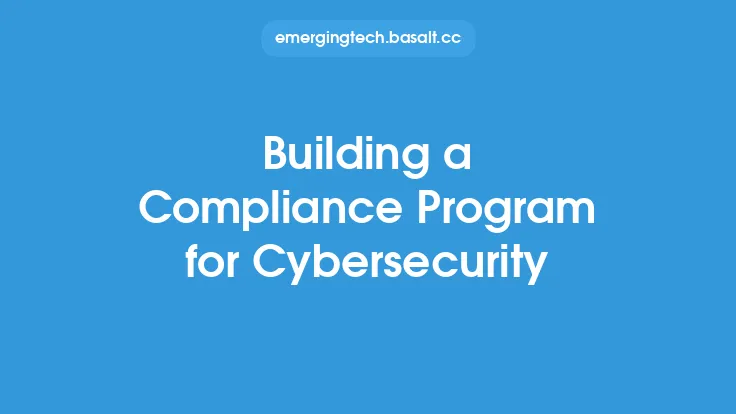Building a robust threat intelligence program is a crucial step for organizations seeking to enhance their cybersecurity posture and stay ahead of emerging threats. A well-structured program provides actionable insights, enabling security teams to make informed decisions and take proactive measures to mitigate potential risks. In this article, we will delve into the key components, best practices, and technical aspects of building an effective threat intelligence program.
Introduction to Threat Intelligence Programs
A threat intelligence program is designed to collect, analyze, and disseminate information about potential or existing threats to an organization's security. The primary goal of such a program is to provide timely and relevant intelligence that enables security teams to take proactive measures to prevent or mitigate attacks. An effective program should be tailored to the organization's specific needs, taking into account its industry, size, and existing security infrastructure.
Key Components of a Threat Intelligence Program
Several key components are essential for building a successful threat intelligence program. These include:
- Data Collection: Gathering relevant data from various sources, such as open-source intelligence, social media, and internal network logs.
- Data Analysis: Analyzing the collected data to identify patterns, trends, and potential threats.
- Threat Modeling: Creating models to simulate potential threats and predict their impact on the organization.
- Intelligence Sharing: Sharing intelligence with relevant stakeholders, such as security teams, management, and external partners.
- Continuous Monitoring: Continuously monitoring the organization's security posture and updating the threat intelligence program accordingly.
Technical Aspects of Threat Intelligence
From a technical perspective, building a threat intelligence program involves several key aspects. These include:
- Data Management: Implementing a data management system to store, process, and analyze large amounts of data.
- Threat Intelligence Platforms: Utilizing threat intelligence platforms, such as threat intelligence gateways or security information and event management (SIEM) systems, to collect, analyze, and disseminate threat intelligence.
- Machine Learning and Artificial Intelligence: Leveraging machine learning and artificial intelligence to analyze data, identify patterns, and predict potential threats.
- Network Traffic Analysis: Analyzing network traffic to identify potential threats and detect anomalies.
- Cloud Security: Integrating cloud security into the threat intelligence program to protect cloud-based assets and data.
Best Practices for Building a Threat Intelligence Program
To build an effective threat intelligence program, several best practices should be followed. These include:
- Define Clear Goals and Objectives: Clearly defining the program's goals and objectives to ensure everyone is working towards the same outcome.
- Establish a Threat Intelligence Team: Establishing a dedicated threat intelligence team to oversee the program and provide expertise.
- Develop a Threat Intelligence Strategy: Developing a comprehensive strategy that outlines the program's scope, goals, and objectives.
- Implement a Continuous Monitoring Process: Implementing a continuous monitoring process to ensure the program stays up-to-date and effective.
- Foster Collaboration and Information Sharing: Fostering collaboration and information sharing between security teams, management, and external partners to ensure everyone is aware of potential threats.
Overcoming Challenges in Building a Threat Intelligence Program
Building a threat intelligence program can be challenging, and several obstacles may arise. These include:
- Data Overload: Managing large amounts of data and filtering out irrelevant information.
- Lack of Resources: Securing sufficient resources, including budget, personnel, and technology.
- Intelligence Sharing: Sharing intelligence with external partners while maintaining confidentiality and security.
- Staying Up-to-Date: Keeping the program up-to-date with the latest threats, technologies, and best practices.
- Measuring Effectiveness: Measuring the program's effectiveness and return on investment.
Conclusion
Building an effective threat intelligence program is a critical step for organizations seeking to enhance their cybersecurity posture and stay ahead of emerging threats. By understanding the key components, technical aspects, and best practices, organizations can develop a robust program that provides actionable insights and enables security teams to make informed decisions. While challenges may arise, overcoming them is crucial to ensuring the program's success and effectiveness. With a well-structured threat intelligence program in place, organizations can proactively mitigate potential risks and protect their assets and data from cyber threats.





